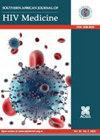Predictors of low antiretroviral adherence at an urban South African clinic: A mixed-methods study
IF 1.6
4区 医学
Q4 INFECTIOUS DISEASES
引用次数: 3
Abstract
Background Low adherence to antiretroviral treatment (ART) in people living with HIV (PLHIV) remains a critical issue, especially in vulnerable populations. Although ART is responsible for greatly reducing the mortality and morbidity associated with HIV, low treatment adherence continues to impact the effectiveness of ART. Considering that a high level of adherence to ART is required for the excellent clinical outcomes with which ART is often associated, understanding the complex contextual and personal factors that limit high levels of treatment adherence remains paramount. Poor adherence remains an issue in many South African communities many years after the introduction of ART. Objectives Our study sought to understand the specific factors and the interactions among them that contribute to non-adherence in this patient population in order to devise successful and contextually appropriate interventions to support ART adherence in PLHIV. Methods This mixed-methods study employed a study-specific questionnaire (N = 103) and semi-structured interviews (N = 8) to investigate the factors linked to non-adherence at the Heideveld Community Day Centre in Cape Town, South Africa. Results Over half (57.3%) of participants were ART non-adherent. Non-adherence was correlated with younger age, negative self-image and a low belief in the necessity of ART (P < 0.05). In patient interviews, alcohol use, treatment fatigue and stigmatisation emerged as contributors to suboptimal adherence. Conclusion The results suggest that there remains a need for context-sensitive interventions to support PLHIV in South African communities. Future research needs to ensure that these targeted interventions take these factors into consideration.南非城市诊所抗逆转录病毒依从性低的预测因素:一项混合方法研究
艾滋病毒感染者(PLHIV)抗逆转录病毒治疗(ART)依从性低仍然是一个关键问题,特别是在弱势人群中。尽管抗逆转录病毒治疗大大降低了与艾滋病毒相关的死亡率和发病率,但治疗依从性低继续影响抗逆转录病毒治疗的有效性。考虑到良好的临床结果需要高水平的抗逆转录病毒治疗,而抗逆转录病毒治疗往往与之相关,了解限制高水平治疗依从性的复杂背景和个人因素仍然是至关重要的。在引进抗逆转录病毒治疗多年后,坚持治疗不力仍然是南非许多社区的一个问题。我们的研究旨在了解导致这一患者群体不坚持治疗的具体因素及其相互作用,以便设计出成功的、适合环境的干预措施,以支持艾滋病毒感染者坚持抗逆转录病毒治疗。方法本研究采用混合方法,采用研究专用问卷(N = 103)和半结构化访谈(N = 8),调查南非开普敦hedeveld社区日间中心与不依从性相关的因素。结果超过一半(57.3%)的参与者是ART非依从性的。不依从性与年龄较小、自我形象消极、对ART必要性的信念较低相关(P < 0.05)。在患者访谈中,酒精使用、治疗疲劳和污名化是导致依从性不佳的原因。结论:研究结果表明,在南非社区,仍然需要对环境敏感的干预措施来支持艾滋病毒感染者。未来的研究需要确保这些有针对性的干预措施考虑到这些因素。
本文章由计算机程序翻译,如有差异,请以英文原文为准。
求助全文
约1分钟内获得全文
求助全文
来源期刊
CiteScore
2.80
自引率
11.80%
发文量
41
审稿时长
>12 weeks
期刊介绍:
The Southern African Journal of HIV Medicine is focused on HIV/AIDS treatment, prevention and related topics relevant to clinical and public health practice. The purpose of the journal is to disseminate original research results and to support high-level learning related to HIV Medicine. It publishes original research articles, editorials, case reports/case series, reviews of state-of-the-art clinical practice, and correspondence.

 求助内容:
求助内容: 应助结果提醒方式:
应助结果提醒方式:


